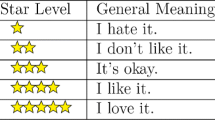Abstract
Opinion targets extraction of Chinese microblogs plays an important role in opinion mining. There has been a significant progress in this area recently, especially the method based on conditional random field (CRF). However, this method only takes lexicon-related features into consideration and does not excavate the implied syntactic and semantic knowledge. We propose a novel approach which incorporates domain lexicon with groups of syntactical and semantic features. The approach acquires domain lexicon through a novel way which explores syntactic and semantic information through Partof-Speech, dependency structure, phrase structure, semantic role and semantic similarity based on word embedding. And then we combine the domain lexicon with opinion targets extracted from CRF with groups of features for opinion targets extraction. Experimental results on COAE2014 dataset show the outperformance of the approach compared with other well-known methods on the task of opinion targets extraction.
Similar content being viewed by others
References
Liu Q, Feng C, Huang H. Emotional tendency identification for micro-blog topics based on multiple characteristics. In Proc. the 26th Pacific Asia Conference on Language, Information and Computation, Nov. 2012, pp.280-288.
Han Z, Zhang Y, Zhang H, Wan Y, Huang J. An effective short text tendency classification algorithm for Chinese microblogging. Computer Application and Software, 2012, 29(10): 89–93. (in Chinese)
Rao D, Ravichandran D. Semi-supervised polarity lexicon induction. In Proc. the 12th Conference of the European Chapter of the Association for Computational Linguistics, Mar. 2009, pp.675-682.
Hu M, Liu B. Mining and summarizing customer reviews. In Proc. the 10th ACM SIGKDD International Conference on Knowledge Discovery and Data Mining, Aug. 2004, pp.168-177.
Li B, Zhou L, Feng S, Wong K. A unified graph model for sentence-based opinion retrieval. In Proc. the 48th Annual Meeting of the Association for Computational Linguistics, July 2010, pp.1367-1375.
Popescu A, EtzioniO. Extracting product features and opinions from reviews. In Natural Language Processing and Text Mining, Kao A, Poteet S R (eds.), Springer-Verlag London, 2007, pp.9-28.
Liu H, Zhao Y, Qin B, Liu T. Comment target extraction and sentiment classification. Journal of Chinese Information Processing, 2010, 24(1): 84–88. (in Chinese)
Zhuang L, Jing F, Zhu X. Movie review mining and summarization. In Proc. the 15th ACM International Conference on Information and Knowledge Management, Nov. 2006, pp.43-50.
JakobN, Gurevych I. Extracting opinion targets in a singleand cross-domain setting with conditional random fields. In Proc. the 2010 Conference on Empirical Methods in Natural Language Processing, Oct. 2010, pp.1035-1045.
Hacioglu K. Semantic role labeling using dependency trees. In Proc. the 20th International Conference on Computational Linguistics, Aug. 2004, Article No. 1273.
Turney P, Littman M. Measuring praise and criticism: Inference of semantic orientation from association. ACM Transactions on Information Systems (TOIS), 2003, 21(4): 315–346.
Lu B, Wan X, Yang J, Chen X. Using TongyiciCilin to compute word semantic Polarity. In Proc. International Conference on Chinese Computing, Aug. 2007, pp.17-23.
Wang S, Li D, Wei Y, Song X. A synonyms based word sentiment orientation discriminating. Journal of Chinese Information Processing, 2009, 23(5): 68–75. (in Chinese)
Mikolov T, Chen K, Corrado G, Dean J. Efficient estimation of word representations in vector space. In Proc. ICLR, May 2013.
Tang D, Wei F, Yang N, Zhou M, Liu T, Qin B. Learning sentiment-specific word embedding for twitter sentiment classification. In Proc. the 52nd Annual Meeting of the Association for Computational Linguistics (ACL), June 2014, pp.1555-1565.
Zhang C, Feng C, Liu Q, Shi C, Huang H, Zhou H. Chinese comparative sentence identification based on multi-feature fusion. Journal of Chinese Information Processing, 2013, 2013(6): 110–116. (in Chinese)
Lu B. Identifying opinion holders and targets with dependency parser in Chinese news texts. In Proc. the NAACL HLT 2010 Student Research Workshop, June 2010, pp.46-51.
Hermjakob U. Parsing and question classification for question answering. In Proc. the Workshop on Open-Domain Question Answering, July 2001.
Hu B, Wang D, Yu G, Ma T. An answer extraction algorithm based on syntax structure feature parsing and classification. Chinese Journal of Computers, 2008, 31(4): 662-676. (in Chinese)
Li X, Roth D. Learning question classifiers. In Proc. the 19th International Conference on Computational Linguistics, Aug. 2002.
Zhu Y, Xu Y, Wang W, Lu L, Du R, Deng C. Research on opinion extraction of Chinese review. In Proc. the 3rd Chinese Opinion Analysis Evaluation, 2011, pp.126-135. (in Chinese)
Sun H, Yu S. Shallow parsing: An overview. Contemporary Linguistics, 2000, 2(2): 74–83. (in Chinese)
Che W, Li Z, Liu T. LTP: A Chinese language technology platform. In Proc. the 23rd International Conference on Computational Linguistics: Demonstrations, Aug. 2010, pp.13-16.
Socher R, Bauer J, Manning C, Ng A. Parsing with compositional vector grammars. In Proc. the 51st Annual Meeting of the Association for Computational Linguistics, Aug. 2013, pp.455-465.
Author information
Authors and Affiliations
Corresponding author
Additional information
A preliminary version of the paper was published in the Proceedings of SMP 2014.
The work was supported by the National Basic Research 973 Program of China under Grant Nos. 2013CB329605 and 2013CB329303, and the National Natural Science Foundation of China under Grant No. 61201351.
Rights and permissions
About this article
Cite this article
Liao, C., Feng, C., Yang, S. et al. A Hybrid Method of Domain Lexicon Construction for Opinion Targets Extraction Using Syntax and Semantics. J. Comput. Sci. Technol. 31, 595–603 (2016). https://doi.org/10.1007/s11390-016-1649-z
Received:
Revised:
Published:
Issue Date:
DOI: https://doi.org/10.1007/s11390-016-1649-z




